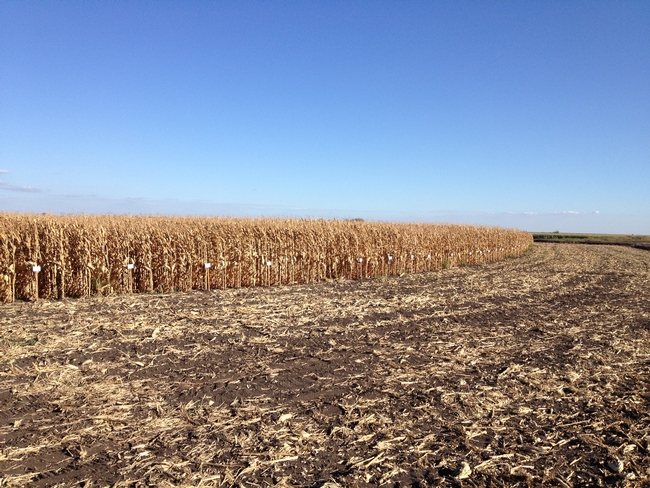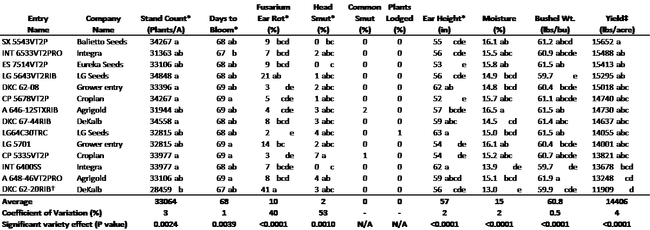
Stand counts were made approximately two weeks after planting. The stand was assessed in the center two rows of each four-row plot, counting the plants along a 10-foot length. Bloom was assessed over the week of July 16th. While planting occurred on the same day as in 2017, the days to bloom was 68 in 2018, averaged across varieties, compared to 65 in 2017. This amounts to an approximate accumulation of 1230 growing degree days (GDD) in both years. In general, the temperatures were lower in 2018 compared to 2017. Over the course of the season, there were four days above 100°F, compared to a total of 14 days over 100°F during the 2017 season. (Temperature data is from the neighboring Staten Island CIMIS station.)
We monitored disease incidence and plant lodging in late September. Disease incidence, particularly Fusarium ear rot, was higher in 2018 compared to the two previous years. A sign of Fusarium ear rot is white fungal mycelium around the kernels. The disease is usually introduced to the ears by corn earworm or by thrips that travel down the corn silks at pollination. Incidence may be reduced in varieties with longer husks that prevent insect infestations. Planting earlier in the season may also reduce incidence, as the crop may reach pollination before insect pests are prevalent. Seed company representatives have indicated that Fusarium ear rot incidence was high in other parts of the state as well.
The table presents mean values for the three replicates. The statistical method used to compare the means is called the Tukey's range test. Varieties were considered statistically different if their P value was less than 0.05, or 5 percent. What this means is that when differences between varieties exist, we are 95% certain that the two varieties are actually different; the results are not due to random chance. Differences between varieties are indicated by different letters following the mean. For example, a variety that has only the letter “a” after the mean yield value is different from a variety that is followed by only the letter “b”, but it is not different from a variety whose mean value is followed by both letters (“ab”). Similarly, a variety whose mean yield is followed by the letters “ab” is not different from a variety whose mean yield is followed by the letters “bc”. Eleven varieties have a letter “a” following their mean yield, which means that those eleven varieties all performed similarly in the trial. In other words, based on this research, we cannot attribute numerical differences to varietal differences. The variety that had the lowest yield in the trial also had the lowest stand count. This may have been the result of the planter settings. Seed inventory records indicate that a standard bag of this variety weighed 54 pounds for 80,000 seeds; whereas, bags of other varieties weighed 39 to 44 pounds for 80,000 seeds. This larger-sized seed may not have dropped consistently from the planter in order to achieve the desired plant stand. Growers should contact the seed company with further questions.
Across varieties, there were also statistical differences in stand count, days to bloom, Fusarium ear rot, head smut, ear height, grain moisture, and bushel weight. The CV, or coefficient of variation, is the standard deviation divided by the mean, or a measure of variability in relation to the mean. For the diseases, the variability among the three replicates was very high.
Special thanks go to the cooperating growers, Steve and Gary Mello, and the participating seed companies. A printable version of these results is available from my website.
Table 1. 2018 UCCE Field Corn Variety Trial Results
Results for each variety are expressed as the average across three replications.
* Data were transformed for analysis. Arithmetic means are presented.
‡ Yield adjusted to 15% moisture.
† Larger seed size and planter settings may have caused lower stand and yield. Contact company representative for more information.
